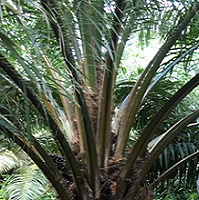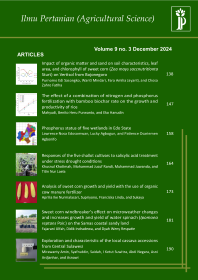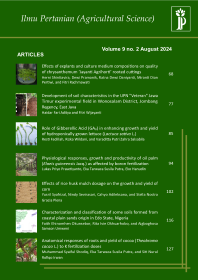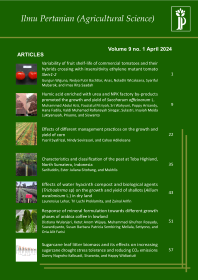
The influence of urease and nitrification inhibitor on loss of N and oil palm harvest in peat
Aldy Slamet Riyadi(1), Eka Tarwaca Susila Putra(2*), Eko Hanudin(3)
(1) Department of Agronomy, Faculty of Agriculture Universitas Gadjah Mada Jln. Flora no. 1, Bulaksumur, Sleman, Yogyakarta 55281
(2) Department of Agronomy, Faculty of Agriculture Universitas Gadjah Mada Jln. Flora no. 1, Bulaksumur, Sleman, Yogyakarta 55281
(3) Department of Soil Sciences, Faculty of Agriculture Universitas Gadjah Mada Jln. Flora no. 1, Bulaksumur, Sleman, Yogyakarta 55281
(*) Corresponding Author
Abstract
Oil palm is one of intensively planted in Indonesia, large-managed for industrial oil palm. This study aimed to know the influences of urease and nitrification inhibitor on loss of N and oil palm harvest in peat. The research was conducted at Sukamandang Village Coconut Plantation, Seruyan Tengah District, Seruyan Regency, Central Kalimantan Province. The research used a single factor of field experimental method with Randomized Completely Block Design (RCBD). Urea and ZA fertilizer were used in this study with the following treatment: N0= Without N, N1= Urea (195 kg.ha-1 N), N2= Urea + 0.12% NBPT-NPPT (195 kg.ha-1 N), N3= Urea (156 kg.ha-1 N), N4= Urea + 0.12% NBPT-NPPT (156 kg.ha-1 N), N5= Ammonium Sulfate (427 kg.ha-1 N), N6= Ammonium Sulfate + 0.8% DMPP (427 kg.ha-1 N), N7= Ammonium Sulfate (324 kg.ha-1 N), N8= Ammonium Sulfate + 0.8% DMPP (324 kg.ha-1 N). The research result indicated that the use of NBPT and DMPP inhibitors did not affect N levels in the leaves and the free fatty acids. Urea + NBPT treatment had no N loss for about 30%–50% which was lower than urea without N, whereas ammonium sulfate + DMPP had smaller N loss than all treatments without N fertilization. Fertilization using urea + NBPT and ammonium sulfate + DMPP increased the production of FFB and yield of oil palm.
Keywords
Full Text:
PDFReferences
Alifikri, G. and N. L. P. Hariastuti. 2019. Peningkatan kualitas minyak kelapa sawit dengan pendekatan lean six sigma – (studi kasus di PT. Sawit mas parenggean). Jurnal Iptek, 23: 47–54.
Alonso-Ayuso, M., J. L. Gabriel and M. Quemada. 2016. Nitrogen use efficiency and residual effect of fertilizers with nitrification inhibitors. European Journal of Agronomy, 80: 1–8.
Andreas, W. K., L. Sutiarso and K. H. Widodo. 2017. Optimasi kualitas tandan buah segar kelapa sawit dalam proses panen-angkut menggunakan model dinamis. Agritech, 37: 101–107.
Arsyad, A. R., H. Junaedi and Y. Farni. 2012. Pemupukan kelapa sawit berdasarkan potensi produksi untuk meningkatkan hasil tandan buah segar (TBS) pada lahan marginal Kumpeh. Jurnal Penelitian Universitas Jambi: Seri Sains, 14: 29–36.
Cantarella, H., R. Otto., J. R. S. Soares and A. G. B. Silva. 2018. Agronomic efficiency of NBPT as a urease inhibitor: A review. Journal of Advanced Research, 13: 19–27.
Darmosarkoro, W., E. S. Sutarta and Winarna. 2003. Teknologi pemupukan tanaman kelapa sawit. Prosiding Lahan dan Pemupukan Kelapa Sawit. 113–134.
Department of Industry. 2007. Gambaran sekilas industri minyak kelapa sawit. http://www. kemenperin.go.id/download/289/Paket-Informasi-Komoditi-Minyak-Kelapa-Sawit& ei=de_,d.bmk.
Gusmawarti and Wardati. 2012. Pemberian pupuk anorganik dan air pada tanah gambut terhadap pertumbuhan kelapa sawit di pre-nursery. Jurnal Agrotek Tropika, 1: 23–26.
Hannum, J., C. Hanum and J. Ginting. 2014. Kadar N, P daun dan produksi kelapa sawit melalui penempatan TKKS pada rorak. Jurnal Online Agroteknologi, 2: 1279–1286.
Hartatik, W. and H. Wibowo. 2018. Efektivitas beberapa jenis pupuk N pada pembibitan kelapa sawit. Jurnal Penelitian Tanaman Industri, 24: 29–38.
Kawakami, E. M., D. M. Oosterhuis, J. L. Snider, and M. Mozaffari. 2012. Physiological and yield responses of with field-grown cotton to application of urea the urease inhibitor NBPT and the nitrification inhibitor DCD. European Journal of Agronomy, 43: 147–154.
Lukito, P. A. and Sudradjat. 2017. Pengaruh kerusakan buah kelapa sawit terhadap kandungan free fatty acid dan rendemen CPO di Kebun Talisayan 1 Berau. Buletin Agrohorti, 5: 37–44.
Menendez, S., I. Barrena, I. Setien, C. Gon-Muruna, J. M. Estavillo. 2012. Efficiency of nitrification inhibitor DMPP to reduce nitrous oxide emission under differen temperatur and moisture condition. Soil Biology and Biochemistry, 53: 82–89.
Ruser, R. and R. Schulz. 2015. The effect of nitrification inhibitors on the nitrous oxide (N2O) release from agricultural soils–a review. Journal of Plant Nutrition Soil Science, 178: 171–188.
Setyaji, H. 2016. Kualitas minyak kelapa sawit kaya karoten dari brondolan kelapa sawit. https:// www.researchgate.net/publication/294259006.
Sudrajat and Fitriya. 2015. Optimasi dosis pupuk dolomit pada tanaman kelapa sawit (Elaeis guineensis jacq.) belum menghasilkan umur satu tahun. Agrovigor, 8: 1–8.
Susila, W. R. 2006. Peluang pengembangan kelapa sawit di Indonesia: perspektif jangka panjang 2025. Jurnal Sosial Ekonomi Pertanian, 6: 1-19
Suter, H., D. Chen, W. Walker, R. Davies. 2012. The potential for inhibitor coated nitrogen fertilizers to reduce agricultural fertiliser N losses. Proceedings of the 16th Australian Agronomy Conference. 1–2.
Wigena, I. G. P., J. Purnomo, E. Tuherkih and A. Saleh. 2005. Pengaruh pupuk “slow release” majemuk padat terhadap pertumbuhan dan produksi kelapa sawit muda pada xanthic hapludox di Merangin, Jambi. Jurnal Tanah dan Iklim, 24: 10–20.
Article Metrics
Refbacks
- There are currently no refbacks.
Ilmu Pertanian (Agricultural Science) ISSN 0126-4214 (print), ISSN 2527-7162 (online) is published by Faculty of Agriculture Universitas Gadjah Mada collaboration with Perhimpunan Sarjana Pertanian Indonesia (PISPI) and licensed under a Creative Commons Attribution-ShareAlike 4.0 International License.













